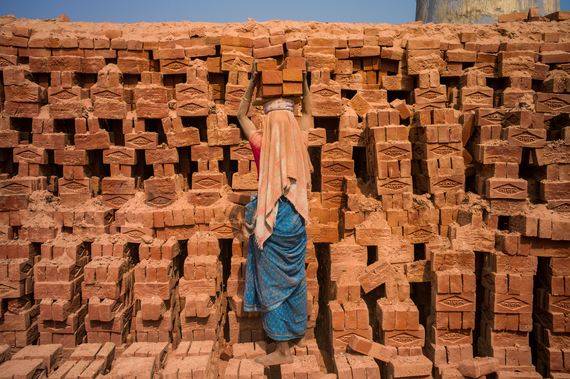Today modern slavery condemns tens of millions of men, women and girls to lives filled with violence, coercion, exploitation and abuse. Unscrupulous criminals prey upon the most vulnerable and marginalised people to generate illegal and unconscionable profits.
Seeta was one of those millions of victims. She and her husband Kishun lived in northern India. He was suffering from tuberculosis and as a result, the couple borrowed $164 from a lender to cover his treatment, to be paid off through their labor.
For over 15 years Seeta and Kishun worked for the lender, paying back over $1,500 -- almost 10 times the original loan -- but the lender treated these as payments of interest only, and forced them to continue working for him. In 2013, Kishun died, with the original debt still owing.
In Northern India alone, hundreds of thousands live as forced and bonded laborers, controlled through fraudulent debts and threats of physical abuse. Families are forced to work in kilns making bricks, or in quarries crushing stones. Boys are locked in dark rooms to weave carpets, and girls forced to work as domestic slaves, or sexually exploited in brothels.
Modern slavery is a hidden crime, though often existing in plain sight -- with corrupt or co-opted officials turning a blind eye, or actively cooperating with the perpetrators.
So how can we tackle this entrenched abuse? At the Freedom Fund we believe in working on the frontlines against slavery , at the community level where we can directly support those enslaved and help them escape their servitude. To build on these efforts we bring in highly respected research institutions to independently review these interventions and assess what is working and what can be improved -- so that the most effective approaches can be replicated and scaled. And we also attack the systems that support slavery -- for instance, by supporting efforts to improve strategic litigation against abusive corporations that knowingly engage in forced labour, or engage in willful blindness of these abuses.
What does this mean in practice? Through our hotspot model, we work in those regions and sectors where slavery has the greatest hold. Our first hotspot project in Northern India has now been running for a year. The Economist magazine has just reported on our results, noting:
In the first year, which has just ended, [Freedom Fund] grants of $1.1m freed 2,193 people, of whom 610 can now support themselves without further help. Nearly 6,000 families were helped to enroll in government benefit programmes, and 5,000 officials were trained to enforce the law and give aid to victims.
Even though it's an impressive achievement to have helped over 2,000 people out of servitude in the programs first year -- there are perhaps 14 million people in forced and bonded labor in India, so these results only scratch the surface. That's where the research comes in, as also noted in the same article:
[T]he Freedom Fund has recruited the Institute for Development Studies at the University of Sussex and Harvard University's FXB Centre for Health and Human Rights to study the hotspots to discover what is working and whether it can be scaled up fast. This will include controlled trials comparing districts in which the NGOs work with similar ones where nothing is being done, and will look at everything from whether freed workers find the alternative work that they need to stay free to whether they actually feel freer and more in control of their own lives. The first results are due in a few months.
In addition to investing in frontline efforts, investing in studies that measure our impact is critical. These research efforts will inform and shape the effective investment of future resources devoted to fighting modern slavery and trafficking -- and not just in Northern India, but across the country and in other countries with high slavery.
Seeta is one woman who has already directly benefited from the Freedom Fund's approach in India. In June, 2014, one of our partners, Adithi, was facilitating a community meeting when Seeta contacted it and shared her story. The workers visited the lender and discussed Seeta's situation and full repayment of the loan. Eventually, the lender agreed that she had sufficiently repaid the loan and signed an agreement acknowledging that she did not owe any more money or labour to him.
Adithi then connected Seeta to a self-help group where she was able to receive services. She opened a bank account and accessed a loan through the group for other income generating activities. Seeta now has the opportunity to live without debilitating debt and, with the support of the self-help group, to remain free from debt bondage, pursuing work of her own choosing.
Seeta's story is just one of the 2,193 stories we could share with you. Hers is one life that has been freed from modern slavery. As we scale up our efforts, the Freedom Fund and its partners on the ground will transform the lives hundreds of thousands more in the coming years. And collectively we can change millions of lives for the better. That's our ambition and our responsibility.

